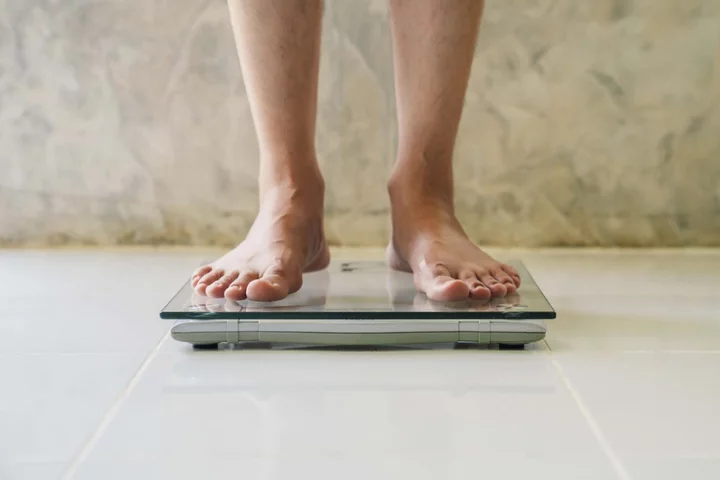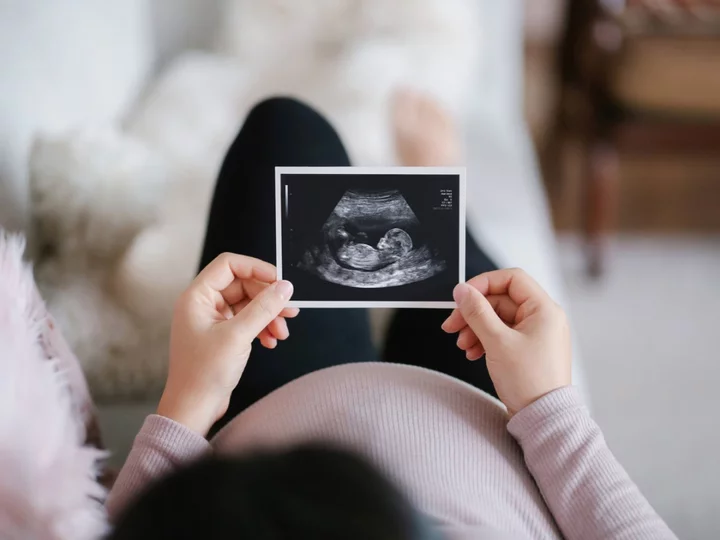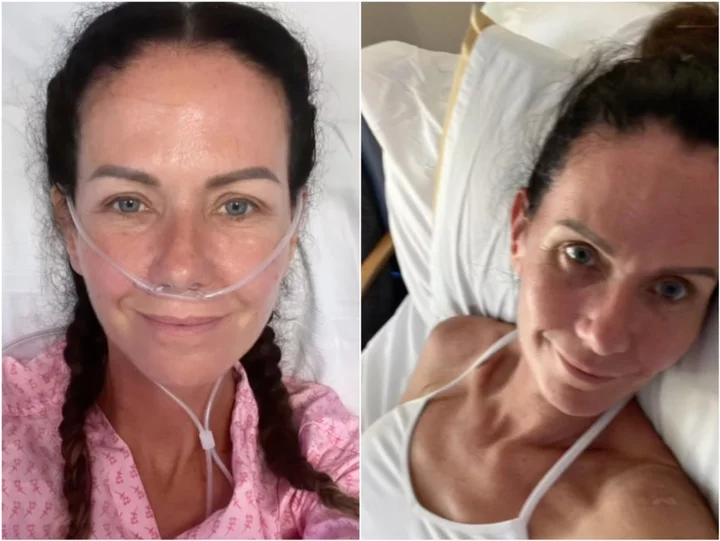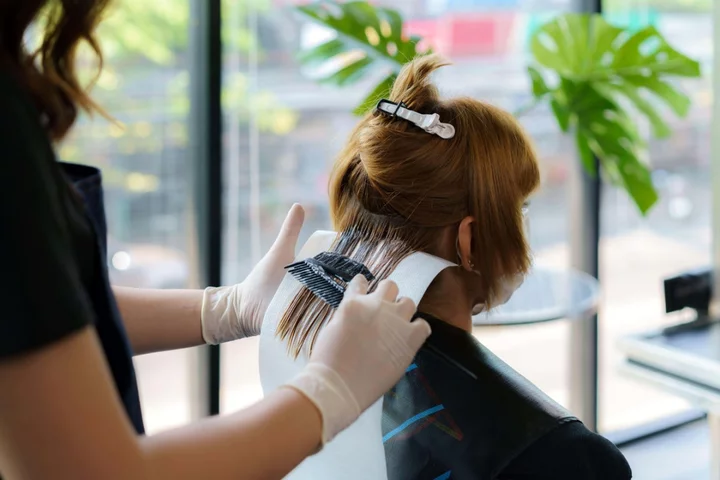
Jennette McCurdy says her mother would ‘measure her thighs’ and ‘weigh her daily’ when she was 11
Jennette McCurdy has detailed how her mother encouraged her to engage in disordered eating when she was 11 years old. The former Nickelodeon star, 31, previously said that her mother, Debra McCurdy, “explicitly” told her how to eat in a way that would delay puberty so that she could continue to land child roles and therefore support her family financially. In a new interview with Louis Theroux on his podcast, The Louis Theroux Podcast, the iCarly actor opened up about exactly what her mother would do to promote disordered eating. “We partnered up to count our calories, she weighed me daily, she measured my thighs with a measuring tape, she taught me what diuretics were and we read calorie books together,” she recalled. McCurdy said that, to her 11-year-old self, it “felt amazing” to be “partners in crime” with her mother, and Debra told her that it was a “secret we shouldn’t tell anyone”. “I thought that was great because it was like a secret code language, nobody else knows what we’re doing, we could nod to each other and know that we were in this together, and nobody would be part of this.” However, Debra’s tactics to keep her daughter’s calories under control led to an “arduous relationship with food” for McCurdy. McCurdy explained that she began acting when she was six years old and began booking more significant roles when she was 11. She recalled playing characters that were younger than her actual age because she looked younger, and how her mother “made it clear that that was really helpful because casting directors like to cast older kids to play younger roles”. The actor said that one day, she felt a “lump” on her chest area and went to her mother out of fear that it was cancer. Debra has been diagnosed with breast cancer when McCurdy was two years old and later recovered. “I always had this fear of cancer recurring for her, cancer for me… it was just a constant fear,” she explained. “She reached her hand up my shirt, felt the lump and said, ‘Oh, Netty, no, you don’t have cancer, you’re just getting boobies.’ “That was truly as horrifying to me because it meant growing up and it had always been really clear to me that my mum did not want me to grow up. Not just for acting, but it also felt like her worth was tied up in me being young. With me being young, she had something to do, she felt good, me growing up kind of felt like her loss of purpose.” McCurdy asked Debra what she could do to “stop” her breasts from growing, which is when she introduced her daughter to calorie restriction. Speaking about her mother’s own eating disorder, which she had had “for years”, McCurdy recalled that Debra began restricting her food intake at the age of 14 by eating “one donut a day”. “The idea that this was abuse, that this was unhealthy, I couldn’t go anywhere near the reality of it,” she said. “I kept clinging to, ‘Oh, mum’s doing this because it’s what’s best for me, it’s what’s best for my career, she clearly wants what’s good for me,’ and I think a part of her believed that she wanted me to have a better life than she had, but I don’t think she ever stopped to consider what that actually meant, what does that look like, what does my daughter want. “She just assumed that her dreams must be everyone’s dreams, because of narcissism, I guess.” In her 2022 memoir, I’m Glad My Mother Died, McCurdy opened up about the abusive childhood she endured at the hands of Debra, who died in 2013 after her breast cancer returned. During her interview with Theroux, she also revealed that her mother would shower her until she was “17 or 18” and would give her “breast and vaginal exams”. “She would give me breast or vaginal exams in the shower and said that she was checking for lumps – she was just checking for cancer,” she recalled. But when McCurdy voiced how “uncomfortable” the experiences were, her mother became “hysterical”. McCurdy grew up in California with Debra, her father Mark McCurdy, and her three older brothers, Dustin, Marcus and Scott. Her best-selling memoir led to a two-book deal with Penguin Random House’s Ballantine Books label. For anyone struggling with the issues raised in this piece, eating disorder charity Beat’s helpline is available 365 days a year on 0808 801 0677. NCFED offers information, resources and counselling for those suffering from eating disorders, as well as their support networks. Visit eating-disorders.org.uk or call 0845 838 2040. Read More Nigella says extravagant dinner parties are a thing of the past – I wish she was wrong From Queen Camilla to Mary Berry: Who is in the Royal Box on the 10th day of Wimbledon? Kevin Costner ‘ordered to pay estranged wife $129k in monthly child support’, double his offer Children say ‘I’m bored’ 7 times a week – 7 ways to prevent it What are weight loss injections and what’s the controversy? What is group B strep? Charity says pregnant women ‘in the dark’
2023-07-12 22:59

What are weight loss injections and what’s the controversy?
With new research emerging, more questions have been raised about weight-loss injections, how they work, and the risks involved. Here are some of your questions answered. What are weight loss injections? Championed by some celebrities, including Elon Musk, weight loss injections were originally created to treat people with type 2 diabetes and other weight-related health issues. They are a type of prescription-based medical treatment that interferes with your metabolism, regulates your appetite and as a result encourages weight loss. The drugs belong to a class of medications known as glucagon-like peptide-1 receptor agonists, or GLP-1 RAs, which mimic the GLP-1 hormone, released in the gut after eating some food. The only FDA-approved stomach injections to help with weight management are semaglutide — sold under the brand names Ozempic, Wegovy and Rybelsus — and liraglutide — sold under Saxenda. But others are in development. Helen Knight, programme director of the Centre for Health Technology Evaluation at the National Institute for Health and Care Excellence (Nice) said: “We know that management of overweight and obesity is one of the biggest challenges our health service is facing with nearly two-thirds of adults either overweight or obese. It is a lifelong condition that needs medical intervention, has psychological and physical effects, and can affect the quality of life. “But in recent years Nice has been able to recommend a new line of pharmaceutical treatments which have shown that those people using them, alongside changes to their diet and exercise, have been able to reduce their weight.” How do they work? According to Nice’s independent appraisal committee, drugs like semaglutide should only be prescribed to patients as an alternative for weight management — alongside a reduced-calorie diet and increased physical activity in adults. They should also have a BMI of at least 35.0 kg/m2 (this is medically classified as obese), and especially, to people with a BMI of 30.0 kg/m2 to 34.9 kg/m2, have non-diabetic hyperglycaemia (blood sugar that is above normal but below those needed to diagnose diabetes) or are at high risk of other weight-related conditions such as strokes and heart attacks, due to other factors such as high blood pressure and high cholesterol. Using semaglutide as an example, a typical dose for weight loss is 2.4 milligrams, administered weekly as under-the-skin self-injections. How are they going to be rolled out? Nice formally recommended liraglutide, orlistat and semaglutide as medicines suitable to use for weight loss earlier this year. And with such drugs also available through online pharmacies by private prescription, a growing number of people have tried the jabs. If they are prescribed alongside a reduced-calorie diet, increased physical activity, and behavioural support, after a year, people taking them can lose up to 15% of their body weight, with results visible within the first month, according to the Nice clinical trials. Some weight loss injections are available on the NHS, but they are only prescribed under certain circumstances. Following an announcement of a £40 million two-year pilot on June 7, the government have said more people living with obesity will have access to the newest and most effective obesity drugs to help cut NHS waiting lists. What are the possible side effects? Europe’s drug regulator The European Medicines Agency (EMA) is investigating whether patients using some weight loss and obesity jabs are at risk of suicidal thoughts and thoughts of self-harm, which highlights some of the controversy surrounding the phenomenon. The EMA safety committee said it is looking at cases among people who use a semaglutide or liraglutide-containing medicine for weight loss – where “signals” were raised by the Icelandic Medicines Agency. “A signal is information on a new or known adverse event that is potentially caused by a medicine and that warrants further investigation,” the EMA said. “The case reports included two cases of suicidal thoughts, one following the use of Saxenda and one after Ozempic. One additional case reported thoughts of self-injury with Saxenda. “The semaglutide-containing medicine Wegovy and the liraglutide-containing medicine Saxenda are authorised for weight loss, together with diet and physical activity. “Suicidal behaviour is not currently listed as a side-effect in the EU product information of these medicines.” If you have a history of medullary thyroid cancer, gallbladder disease, or even pancreatitis, you should avoid taking weight loss injections like semaglutide. People who do take the prescription drug for weight loss sometimes experience dizziness, fatigue, and gastrointestinal issues — the most common side effects among patients — such as diarrhoea, constipation and gassiness. They are also at risk of getting headaches and stomach conditions including vomiting, bloating and nausea. Read More Charity boss speaks out over ‘traumatic’ encounter with royal aide Ukraine war’s heaviest fight rages in east - follow live Journalist and author Yomi Adegoke on the real-life consequences of social media What is group B strep? Charity says pregnant women ‘in the dark’ Britney Spears: I worked my ass off to get my memoir written
2023-07-12 22:26

South Korean zoo celebrates birth of first twin pandas
A giant panda at a South Korean zoo has given birth to the country's first twin cubs.
2023-07-12 16:20

You Can Save Big on These 20 Amazon Basics Products During Prime Day 2023
Love Amazon’s budget-friendly house line? With these Prime Day deals, you can snag Amazon Basics products for even more affordable prices.
2023-07-12 06:57

Kim Kardashian in talks to buy back beauty firm stake from Coty - WSJ
(Reuters) -Kim Kardashian is in talks with Coty to buy back a minority stake in her beauty firm from the
2023-07-12 05:29

Tennis star Naomi Osaka welcomes baby girl with boyfriend Cordae
Naomi Osaka has welcomed a baby girl with rapper boyfriend Cordae. The 25-year-old tennis star welcomed her first child in Los Angeles, People reported on Tuesday 11 July. “They are doing well,” a source told the outlet. The couple, who have been dating since 2019, announced they were expecting their first child together in January. “Can’t wait to get back on the court but here’s a little life update for 2023,” Osaka captioned an Instagram post, which featured a photo of the baby’s ultrasound. In June, the four-time grand slam champion revealed on Instagram that she was expecting a baby girl. Osaka shared several photos from the princess-themed baby shower, which included a large sign with the words: “A Little Princess Is on the Way” Another photo showed the “Doomsday” rapper kissing Osaka’s growing baby bump. The pro athlete simply captioned the post with a purple and white heart emoji. Although Naomi Osaka is currently focused on being a mother, the former world number one tennis player still plans on returning to the court in 2024, after she had withdrawn from the Australian Open earlier this year. “The past few years have been interesting to say the least, but I find that it’s the most challenging times in life that may be the most fun,” she wrote in her pregnancy announcement. “These few months away from the sport has really given me a new love and appreciation or the game I’ve dedicated my life to,” Osaka continued. “I realise that life is so short and I don’t take any moments for granted, everyday is a new blessing and adventure. I know that I have so much to look forward to in the future, one thing I’m looking forward to is for my kid to watch one of my matches and tell someone, ‘that’s my mom’.” “2023 will be a year that’ll be full of lessons for me and I hope I’ll see you guys in the start of the next one ‘cause I’ll be at Aus 2024,” she added, confirming her return to the 2024 Australian Open. “Love you all infinitely.” While the couple have not yet revealed the name of their newborn baby, Osaka previously hinted at some of her baby name choices. “We have been discussing names. I would say that we are going for something more unique than traditional,” she told People earlier this year. Throughout her pregnancy, the Japanese tennis player admitted that she was gearing up to become the “best version” of herself for her daughter. “I would say for me, I just want to be the best version of myself,” Osaka said. “Obviously, I’ve never been a mother before so I’m taking it day-by-day and just trying to be someone that my son or daughter will be proud of.” Read More Naomi Osaka announces pregnancy and will miss rest of 2023 tennis season Naomi Osaka says she's pregnant, plans tennis return in 2024 Serena Williams announces pregnancy and shows off baby bump at Met Gala Foetuses use ‘greedy’ father gene to get more nutrients from mothers, study finds The meaning behind the name of Carrie and Boris Johnson’s third child Emilia Clarke’s brain haemorrhage ‘profoundly changed our lives’, says star’s mother
2023-07-12 04:57

Unborn babies use ‘greedy’ father gene to get more nutrients from mothers, study finds
Unborn babies are in a perpetual nutritional tug-of-war with their mothers due to a “greedy” gene inherited from their fathers, a new study suggests. Scientists from the University of Cambridge have found that foetuses use the gene to “remote-control” their mother into feeding them extra food and control her metabolism. While the mother’s body wants the baby to survive, it needs to keep enough glucose and fats circulating in her system for her own health in order to be able to deliver the child, breastfeed, and reproduce again. Amanda Sferruzzi-Perri, professor in Foetal and Placental Physiology, a Fellow of St John’s College and co-senior author of the paper, said: “It’s the first direct evidence that a gene inherited from the father is signalling to the mother to divert nutrients to the foetus.” Dr Miguel Constancia, MRC investigator based at the Wellcome-MRC Institute of Metabolic Science and co-senior author of the paper, said: “The baby’s remote control system is operated by genes that can be switched on or off depending on whether they are a ‘dad’s’ or ‘mum’s’ gene’, the so-called imprinted genes. “Genes controlled by the father are ‘greedy’ and ‘selfish’ and will tend to manipulate maternal resources for the benefit of the foetuses, so to grow them big and fittest. “Although pregnancy is largely cooperative, there is a big arena for potential conflict between the mother and the baby, with imprinted genes and the placenta thought to play key roles.” The new study looked at how the placenta communicates with the mother through the release of hormones so she can accommodate her baby’s growth. In pregnant mice, scientists selectively altered the signalling cells in the placenta that tell mothers to allocate nutrients to her developing foetuses. The baby’s genes controlled by the father tend to promote foetal growth and those controlled by the mother tend to limit foetal growth, experts say. Professor Sferruzzi-Perri explained: “Those genes from the mother that limit foetal growth are thought to be a mother’s way of ensuring her survival, so she doesn’t have a baby that takes all the nutrients and is too big and challenging to birth. “The mother also has a chance of having subsequent pregnancies potentially with different males in the future to pass on her genes more widely.” In the study researchers deleted the expression of an important gene called Igf2, which provides instructions for making a protein called “Insulin Like Growth Factor Two”. Similar to the hormone insulin, which is responsible for making glucose and controlling its levels in our circulation, the gene promotes foetal growth and plays a key part in the development of tissues including the placenta, liver, and brain. Dr Jorge Lopez-Tello, a lead author of the study based at Cambridge’s department of physiology, development and neuroscience, said: “If the function of Igf2 from the father is switched off in signalling cells, the mother doesn’t make enough amounts of glucose and lipids – fats – available in her circulation. “These nutrients, therefore, reach the foetus in insufficient amounts and the foetus doesn’t grow properly.” The scientists found that deleting the gene also affects production of other hormones that modulate the way the mother’s pancreas produces insulin, and how her liver and other metabolic organs respond. Babies with Igf2 gene defects can be overgrown or growth-stunted. And the researchers say that until now, it was not known that part of the gene’s role is to regulate signalling to the mother to allocate nutrients to the unborn child. The mice studied were smaller at birth and their offspring showed early signs of diabetes and obesity in later life. Professor Sferruzzi-Perri said: “Our research highlights how important the controlled allocation of nutrients to the foetus is for the lifelong health of the offspring, and the direct role the placenta plays. “The placenta is an amazing organ. At the end of pregnancy, the placenta is delivered by the mother, but the memories of how the placenta was functioning leaves a lasting legacy on the way those foetal organs have developed and then how they’re going to function through life.” The findings are published in the Cell Metabolism journal. Reporting by PA Read More It took until my thirties to realise I might not be white Carrie Johnson announces birth of third child with Boris Johnson: ‘Guess which name my husband chose’ How many children does Boris Johnson have? The meaning behind the name of Carrie and Boris Johnson’s third child Emilia Clarke’s brain haemorrhage ‘profoundly changed our lives’, says star’s mother How many children does Boris Johnson have?
2023-07-11 23:21

Frank Alfred Odysseus: The meaning behind the name of Carrie and Boris Johnson’s third child
On Tuesday 11 July, Carrie Johnson announced that she and former prime minister Boris Johnson have welcomed their third child together. Frank Alfred Odysseus Johnson was born on 5 July ay 9.15am, Carrie revealed in an Instagram post before joking: “Can you guess which name my husband chose?” Much has already been made about the choice of names on social media, with people quick to point out that the former PM is a fan of the Greek poet Homer and his epic poem The Odyssey, which tells the story Odysseus. But what does the name – and the child’s other names – actually mean? Odysseus takes its moniker from Homer’s poem, which follows the legendary king of the island of Ithaca on his , who is returning home at the end of the 10-year Trojan War. His journey takes an additional 10 years, during which his crewmates perish and he must face a number of threats. In the poem, which covers a decade-long journey, Odysseus is portrayed as exceptionally intelligent and courageous. He is one of the most influential Greek mythology heroes and the name is often associated with wisdom, pride, and heroism. As for the newborn’s first and second names, Frank comes from the Medieval Latin term, “Francus”, which means “free, at liberty, and exempt from service”, according to etymonline.com. It’s also thought to be connected to the Old French word, “franc”, which, similarly, means “not servile”, with other associations including sincere, genuine, open, gracious, generous, worthy, noble, and illustrious. However, Merriam-Webster claims that the name Frank itself comes from the Franks, “a West Germanic people who lived long ago”. The dictionary continues: “In the early Middle Ages the Franks were in power in France. (It was from them that the country got its name, in Latin Francia.) “The Franks eventually merged with the earlier Gaulish and Roman inhabitants, and their name (Francus in Latin) lost its ethnic sense and referred to any inhabitant of Francia who was free, that is, not a slave or bondman.” As for Alfred, the name is believed to mean “elf counsel” and is derived from the Old English name, Ælfræd. It’s a name often associated with wisdom and is most commonly associated with famous Alfreds, including the ninth-century king, Alfred the Great, filmmaker Alfred Hitchcock, and the poet Lord Alfred Tennyson. In 2019, the former PM was accused of misquoting Lord Tennyson while discussing Brexit, pledgingthat Britain would leave the EU on 31 October “do or die, come what may”. The phrase is often linked to Tennyson’s poem, The Charge of the Light Brigade, except the quote is, “Theirs not to reason why, theirs but to do and die”. Read More Carrie Johnson announces birth of third child with Boris Johnson: ‘Guess which name my husband chose’ How many children does Boris Johnson have? Buckingham Palace responds to Joe Biden’s ‘protocol breach’ with King Charles Rishi Sunak to meet King Charles as Truss defends her record - live Johnson was ‘begging people for votes’ in a ‘demeaning’ way, says IDS Welcome, PM Sunak – the last best option to take over from Truss
2023-07-11 22:54

Emilia Clarke’s brain haemorrhage ‘profoundly changed our lives’, says star’s mother
Emilia Clarke’s mother has described how her daughter’s brain haemorrhage changed the Clarke family “in an instant”. Emilia, who played Daenerys Targaryen on Game Of Thrones, and her mother set up a brain injury charity after the star survived two life-threatening brain conditions while she was filming the hit TV show. Jenny Clarke said it feels like her daughter’s brain haemorrhage – a bleed on the brain – “feels like yesterday” even though it was more than a decade ago. The incident, which took place when Emilia was working out in a north London gym in 2011, was “completely out of the blue”, Jenny said. She said her daughter fought to stay conscious even though she was in “the worst pain she could ever imagine”. Emilia, now aged 36, was taken to a hospital in London but medics did not immediately spot that she had suffered a brain haemorrhage and it took “a long time” before she was sent to a specialist hospital where she received life-saving care, Jenny told the PA news agency. Jenny said there needs to be more awareness among medics about brain haemorrhages in young people because the condition is traditionally seen as something that happens to older people. Emilia also had to have a second procedure in 2013 where surgeons in New York had to remove a brain aneurysm which was found through routine check-ups. The Me Before You star and her mother have since set up the charity SameYou which is working to develop better recovery treatment for survivors of brain injury and stroke. Jenny, who is chief executive of the charity, said that rehabilitation after brain injury is “undervalued and under-prioritised” and should be a “key component of universal health coverage”. She said that while people with serious side effects of brain injury – such as mobility or speech and language problems – do get support, there is often little or no help for people who suffer mild to moderate problems. Jenny told PA: “It feels like yesterday to us really, because it was just such a profound shock. “She had just started Game Of Thrones, the first season had been filmed and she had just come back from a press tour. “And then she had her first brain haemorrhage which was completely out of the blue – it was a morning in March and she was in the gym and she suddenly felt this terrible pain in her head – she’s been quoted as saying it was the worst pain she could ever imagine. “She also realised that something was seriously wrong with her because the pain was so intense. “So she did her best, as she was lying semi-unconscious on the floor of the gym, to try and make sure she kept a sense of what was around her and she fought to make sure that she didn’t lose consciousness.” Jenny added: “When she was rushed to a hospital in London, it was very difficult to establish what has happened to her – and that’s also something that we think is very important; maybe there isn’t enough specialist information and training to actually recognise what happens when you have a brain haemorrhage when you’re young. “People expect people to have strokes and brain haemorrhages when they’re older, it’s a problem of older age, but Emilia was 23 when she had her first brain haemorrhage, so people didn’t recognise it as a brain haemorrhage. “So it took a long time before she was admitted to the wonderful Queen Square (the National Hospital for Neurology and Neurosurgery), which is part of University College London Hospitals and literally her life was saved because of an intervention to stop the bleeding. “But it was three weeks in hospital before we knew whether she was going to have another stroke, and whether she would have different health problems as a result of the brain haemorrhage.” Jenny continued: “When it comes completely out of the blue, your life is just changed in an instant. And I must say that our lives have been continuously changed because of it.” After describing the second “open head surgery” in the US, Jenny said: “Those two great big shocks really have profoundly changed all of us as a family.” The comments come as Jenny attended the launch of the World Health Organisation’s (WHO) Rehabilitation Alliance in Geneva – a coalition which is calling on countries to do more for people in need of rehabilitation services. Jenny delivered a speech to the WHO about the power of advocacy, saying: “There is huge power if survivors come together with one voice to demand that integrated rehabilitation is moved up the agenda. “One in three people will experience a brain injury. They are the most powerful advocates – and this meeting is calling for their needs to be heard and action to be taken.” On rehabilitation for brain injury survivors, she told PA: “As a young person… when something like this happens, you absolutely must have as much support as possible and it just doesn’t really exist. “If you have severe consequences of brain injury, of course, there are many places helping people if you’ve got strong long-term, serious conditions, but what we found was, is that you can have mild to moderate brain injury – and that means you don’t have any necessarily physical issues; you don’t have necessarily any speech and language difficulties, but you do always have the trauma that you’ve had the problem – and there is a just a huge lack of awareness that this is important enough to put resources to get it treated.” She added: “Rehabilitation is undervalued and under-prioritised and that’s clearly got to change as a key component of universal health coverage. “It was such a shock when it happened to us, when Emilia had her brain injury. “We’ve had thousands of people write to us, and so it’s not just our own lived experience, there’s just not enough provision, not enough services available. “There is a great unmet need and a gap in service provision after you’ve survived a brain injury, and you’re trying to rebuild your life, particularly if you’re a young adult. “And what we are advocating for is there needs to be a lot more information given to survivors of brain injury, about what’s happened to them and their opportunity to get recovery services. “There is a gap between what survivors and their families say they need and want and what is currently available in many developed countries.” Read More It took until my thirties to realise I might not be white Carrie Johnson announces birth of third child with Boris Johnson: ‘Guess which name my husband chose’ Buckingham Palace responds to Joe Biden’s ‘protocol breach’ with King Charles Charity boss speaks out over ‘traumatic’ encounter with royal aide Ukraine war’s heaviest fight rages in east - follow live
2023-07-11 22:28

What is ‘bed rotting’ and is it actually self-care?
With 3.2 million views of the TikTok tag ‘bed rotting’ and copious videos, it seems Gen Z are embracing a slower pace of life, with self-care happening in bed. Creators are sharing their morning routines and experiences of bed rotting for self-care, but the trend has come under fire for its potential health implications. Content creator Vanessa Hill describes it in her video as: “When you do literally nothing but laying in bed. It is the end of optimisation.” According to psychologist and The Beekeeper House founder and CEO Robert Common, “Bed rotting is the practice of spending an extended amount of time during your normal waking hours, or even a whole day, lying in bed. You could be watching films, scrolling on social media, talking on the phone, eating, or anything you would normally do if you were at home relaxing. “This differs from bed rest to recover from illness or injury, and is often used as a method of dealing with stress or anxiety, or as a self-care tool,” he explains. This is a shunning of hustle culture and productivity in the pursuit of self-care. “Although bed rotting might be the hottest self-care method trending on TikTok, the idea behind it isn’t new,” says Common. “People have been taking ‘duvet days’ for a long time now, and many companies even have policies around this, allowing staff an entitlement to several duvet days per year. “What we are seeing with this trend is more a case of social media driving conversations among young people. It could be especially appealing to Gen Zs, as many report feeling more stressed than other generations, so taking time away from it all to recuperate mentally could be especially appealing,” he explains. But, is it actually self-care or is it doing more harm than good? The benefits There are some positive aspects to this grimly named practice. “Taking some mental downtime to recharge has many benefits,” says Common. “We live in a very fast-paced world, so stepping back, reconnecting with yourself, recharging your batteries and rebuilding some mental and physical energy is always a positive thing to do. In fact, it’s something that more of us should be scheduling into our routines if we can. “Having this downtime puts us in a stronger position to reassess our goals and find the motivation to reach for them, manage our commitments and explore personal interests and hobbies without burning ourselves out,” he explains. Damage to mental health and physical wellbeing “Spending the odd day here and there throughout the month bed rotting is unlikely to do you any damage – quite the reverse. However, as with all things in life, balance is key,” explains Common. For example, “If bed rotting becomes a dominating factor or behaviour in how you spend your free time, this could be an indicator of depression or burnout. If you suspect you’re experiencing these – or other underlying health issues – it’s important to seek appropriate support to help identify the root causes, and find healthy ways to manage them,” he says. Other practices may be more beneficial. “Whilst rest is important for wellbeing, exercise is also a powerful tool for maintaining good mental and physical health, so ultimately, it’s about not being on either extreme of the spectrum.” Impact on sleep Bed rotting can impact the amount and the quality of sleep you get, too. “An important factor of good sleep hygiene is reserving your bed for sleeping only,” Common says. “Watching Netflix, scrolling on your phone and eating are some of the most obvious activities that go hand-in-hand with bed rotting, but it can make it harder to follow a good sleep schedule. “It’s also important to expend enough energy during the day to fall asleep on time, and maximise the benefits that come with proper sleep,” he says. So, while a few duvet days here and there could be counted as self-care, bed rotting too often may leave you worn out and unhappy. Read More Charity boss speaks out over ‘traumatic’ encounter with royal aide Ukraine war’s heaviest fight rages in east - follow live Beekeeping has gone viral – but how easy is it? Women in certain professions ‘may be at higher risk of ovarian cancer’ – study Everything you need to know about sleep in pregnancy
2023-07-11 21:52

Ben Cohen’s ex-wife Abby says she had only ‘one symptom’ before cancer diagnosis
Ben Cohen’s ex-wife Abby has been diagnosed with cancer. The professional photographer, 44, who shares two children with Cohen, shared a video to her Instagram account documenting her experience with cancer, describing it as the “toughest yet”. In the video, Abby is seen walking into a hospital before undergoing different tests. Several clips show her in a hospital bed, wearing a stoma bag while she is surrounded by her loved ones. Writing on Instagram, Abby recalled that she visited a doctor after having experienced only one symptom. She did not specify where the cancer had been found. “This was and is the toughest yet. I’m unlucky, but lucky, to have been warned only once with a symptom of this terrible illness,” wrote Abby in the post’s caption. She thanked the NHS for “saving” her “life” and taking care of her when she was so “scared and most vulnerable”. The photographer urged her followers to “never ignore” their bodies when warning signs present themselves. “I didn’t [ignore them] and it’s given me a chance to live my new life. In time and with the right treatment, I’m hoping this WILL all be a distant memory for me,” she said. Abby and Ben share twin 15-year-old daughters, Harriette and Isabelle. In the video, the children are seen supporting their mother during her time in hospital. Their father Ben, who is a former England Rugby player, and Abby were married for 11 years before they split in 2014. Cohen went on to start a relationship with his Strictly Come Dancing partner Kristina Rihanoff, whom he was partnered up with during his appearance on the show in 2013. Ben and Kristina welcomed a daughter, Mila, in 2016. The photographer went public with her new partner, David, in 2020. Speaking to MailOnline previously, Abby said that she did not want to be known for her past relationship. “I thought, ‘Everyone still labels me Ben’s ex’ but I’m not that Abby any more. I’m me. I’ve got my two girls. My life. I’ve finally met a really nice man. I want to be known as ‘Abby the good photographer’ or ‘Abby the great mum’. I’m very different. I’m stronger,” she said. Abby has continued to praise Ben as a “fantastic hands-on father”. Read More Woman shares co-worker’s ‘infuriating’ response to her decision to not have children Buckingham Palace responds to Joe Biden’s ‘protocol breach’ with King Charles 5 late summer blooms to plant now Maria Menounos says her tumour ‘doubled’ after first cancer symptoms were overlooked How to check if you have skin cancer: Symptoms and signs to look out Jonnie Irwin makes rare red carpet appearance as he says ‘every day is a gift’
2023-07-11 17:25

Women in certain professions ‘may be at higher risk of ovarian cancer’ – study
Hairdressers, beauticians and accountants could be at a higher risk of developing ovarian cancer, a new study suggests. Those working in sales, retail, clothing and construction industries could also carry a higher risk according to a new study published in the journal Occupational and Environmental Medicine. But the authors of the study stressed that “inferences from the results are limited” as they called for more work to examine the links between ovarian cancer risk and different occupations. The team, led by academics at the University of Montreal in Canada, examined data on 491 Canadian women with ovarian cancer and compared it with 897 women without disease. We observed associations suggesting that accountancy, hairdressing, sales, sewing and related occupations may be linked to excess risks Report authors The researchers linked occupations to ovarian cancer risk. They also compared this data to the Canadian job-exposure matrix to examine any potential workplace exposures – for example, if they are more likely to come in contact with a certain chemical while at work. After accounting for potentially influential factors, they found that some jobs may be linked to a heightened risk of disease. Those who had worked as a hairdresser, barber or beautician appeared to have a three-fold higher risk. Meanwhile, women who worked in accountancy for a decade were twice as likely to develop the disease while construction workers were almost three times as likely. Shop assistants and sales people had a 45% increased risk while those who make or alter clothes appeared to have an 85% increased risk. The researchers said that those found to have a higher risk were also more likely to be exposed to a number of “agents” including: cosmetic talc, ammonia, hydrogen peroxide, hair dust, synthetic fibres, polyester fibres, organic dyes, and pigments and bleaches. “We observed associations suggesting that accountancy, hairdressing, sales, sewing and related occupations may be linked to excess risks,” the authors wrote. “Further population-based research is needed to evaluate possible hazards for female workers and occupations commonly held by women.” In a linked editorial, academics from the National Cancer Institute in Maryland in the US, point out that women are under-represented in “occupational cancer research studies”. They said the study “reminds us that while the lack of representation of women in occupational cancer studies — and indeed, even potential strategies to address this issue — have been long recognised, there is still a need for improvement in studying women’s occupational risks. “By excluding women, we miss the opportunity to identify risk factors for female-specific cancers, to evaluate whether sex-specific differences in risk occur, and to study exposures occurring in occupations held primarily by women.” Commenting on the study, Kevin McConway, emeritus professor of applied statistics at the Open University, said: “The researchers clearly state that their study was ‘exploratory’ and that it is ‘aimed at generating new hypotheses’. “So, it is certainly not claiming that they have definitely found occupational groups, or exposures to chemicals and other agents, that are associated with ovarian cancer. “Even less are they claiming that being in certain occupations, or being exposed to certain chemicals at work, causes an increased risk of ovarian cancer. “Instead, they aimed at suggesting occupational groups, and agents to which women might be exposed at work, that possibly might be associated with ovarian cancer risk, and they say clearly that further research is needed to ‘give a more solid grounding’ to any conclusions that might be drawn about associations between what women do at work and their risk of getting ovarian cancer.” Read More Charity boss speaks out over ‘traumatic’ encounter with royal aide Ukraine war’s heaviest fight rages in east - follow live Beekeeping has gone viral – but how easy is it? Everything you need to know about sleep in pregnancy Myleene Klass: Government does not deserve power if miscarriage policy unchanged
2023-07-11 16:52
